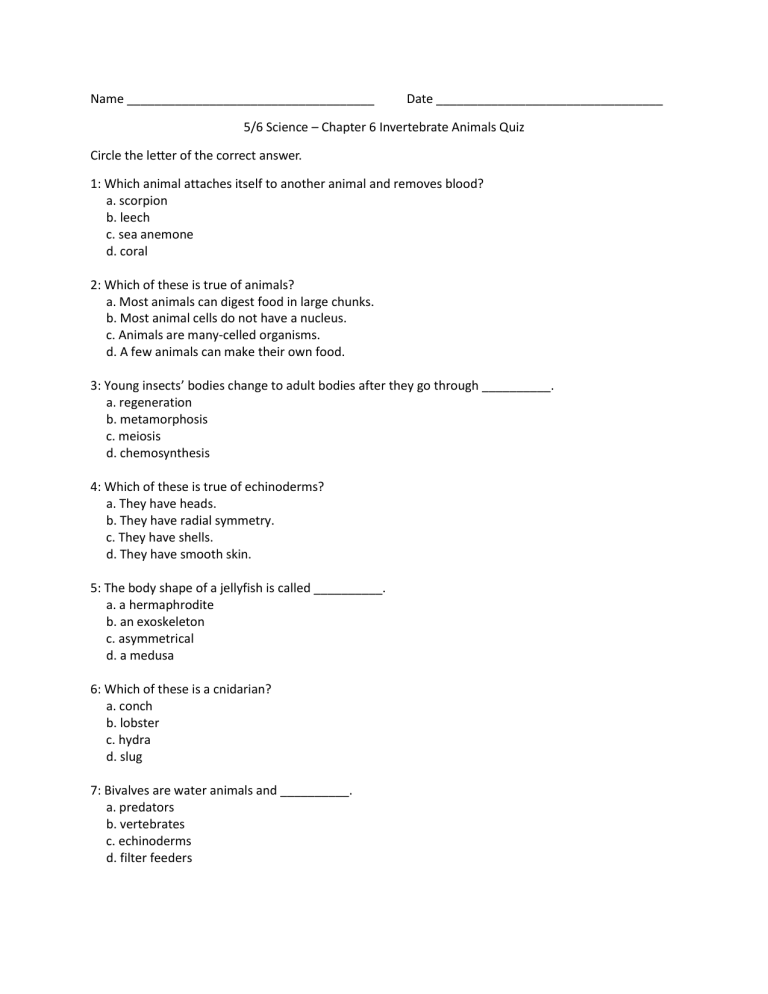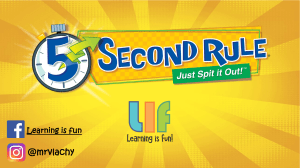
Name ____________________________________ Date _________________________________ 5/6 Science – Chapter 6 Invertebrate Animals Quiz Circle the letter of the correct answer. 1: Which animal attaches itself to another animal and removes blood? a. scorpion b. leech c. sea anemone d. coral 2: Which of these is true of animals? a. Most animals can digest food in large chunks. b. Most animal cells do not have a nucleus. c. Animals are many-celled organisms. d. A few animals can make their own food. 3: Young insects’ bodies change to adult bodies after they go through __________. a. regeneration b. metamorphosis c. meiosis d. chemosynthesis 4: Which of these is true of echinoderms? a. They have heads. b. They have radial symmetry. c. They have shells. d. They have smooth skin. 5: The body shape of a jellyfish is called __________. a. a hermaphrodite b. an exoskeleton c. asymmetrical d. a medusa 6: Which of these is a cnidarian? a. conch b. lobster c. hydra d. slug 7: Bivalves are water animals and __________. a. predators b. vertebrates c. echinoderms d. filter feeders 8: About 97 percent of all animals are __________. a. crustaceans b. carnivores c. asymmetrical d. invertebrates 9: What does a mollusk use its radula for? a. to sleep b. to reproduce c. to eat d. to swim 10: Which of these is true? a. Cephalopods have closed circulatory systems. b. Cephalopods are sessile. c. A slug is a cephalopod. d. All cephalopods have shells. 11: Which of these describes how a sponge eats? a. They are perennial. b. They are scavengers. c. They are filter feeders. d. They are prokaryotic. 12: Which of these animals has radial symmetry? a. a sea star b. a sponge c. a leopard d. a beetle 13: Segmented worms are __________. a. arthropods b. annelids c. vertebrates d. echinoderms 14: How is a spider different from a fly? a. A spider has three body regions, and a fly has two body regions. b. A spider has four pairs of legs, and a fly has three pairs of legs. c. A spider is an invertebrate, and a fly is a vertebrate. d. A spider is a filter feeder, and a fly is a parasite. 15: How does a tapeworm grow? a. by adding sections behind its head b. by converting energy from the Sun into food c. by budding d. by asexual reproduction 16: Arthropods have __________. a. jointed appendages (legs/feet) b. sucking disks c. segmented bodies d. eight body regions CORRECT 17: What type of symmetry does a lobster have? a. trisymmetry b. asymmetry c. bilateral symmetry d. radial symmetry 18: Which of these protects a sponge’s body? a. cartilage b. skin c. spicules d. appendages 19: A mussel is a __________. a. millipede b. sponge c. cnidarian d. mollusk 20: Flatworms that live in or on their hosts are called __________. a. echinoderms b. parasites c. cephalopods d. polyps EXTRA CREDIT (5 points) – Choose ONE of the following and write your answer below and/or on back of this sheet. A. Write a poem (at least 4 lines) about any invertebrate you choose, - OR B. Write 2 diary entries (each with a date and at least 2 sentences) from the point of view of an earthworm and its daily life of moving, eating, etc. – OR – C. Draw a detailed picture of an invertebrate you choose, and label at least 4 parts


